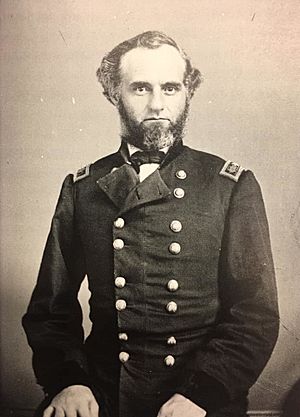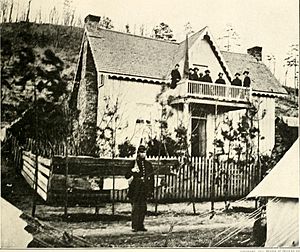Richard W. Johnson facts for kids
Quick facts for kids
Richard W. Johnson
|
|
|---|---|

Brigadier General Richard W. Johnson, c. 1864
|
|
| Born | February 27, 1827 Smithland, Kentucky |
| Died | April 21, 1897 (aged 70) Saint Paul, Minnesota |
| Place of burial |
Oakland Cemetery, Saint Paul, Minnesota
|
| Allegiance | United States of America |
| Service/ |
Union Army |
| Years of service | 1849–1866 |
| Rank | |
| Commands held | 3rd Kentucky Cavalry Regiment Second Division, XX Corps Sixth Division, Cavalry Corps First Division, XIV Corps Cavalry Corps, Military Division of the Mississippi |
| Battles/wars | American Civil War |
| Other work | soldier, author |
| Signature | |
Richard Woodhouse Johnson (born February 27, 1827, died April 21, 1897) was an important officer in the Union Army during the American Civil War. He was known for leading soldiers in many major battles.
Contents
Early Life and Military Career
Richard W. Johnson was born in Smithland, Kentucky. He grew up and later married Rachael Elizabeth Steele. They had two sons, Alfred and Richard.
Becoming a Soldier
Johnson studied at the United States Military Academy, also known as West Point. He graduated in 1849. Before the Civil War began, he worked mostly in frontier areas, helping to keep peace and order.
In 1861, when the Civil War started, Johnson became a lieutenant colonel in the 3rd Kentucky Cavalry Regiment. Soon after, he was promoted to brigadier general. This meant he was in charge of a large group of soldiers.
Early War Challenges
As a cavalry commander, Johnson took part in battles in the western parts of the country in 1861 and 1862. However, on August 21, 1862, he faced a tough challenge. He was defeated and captured by a Confederate officer named John Hunt Morgan. Johnson had been sent to remove Morgan's forces from Tennessee, but the plan didn't work out as hoped.
Fighting in the Civil War
Richard W. Johnson played a big role in many key battles of the Civil War. He often led divisions, which are large groups of soldiers.
Major Battles and Commands
- Battle of Stones River: In 1863, Johnson commanded a division on the right side of the Union army. His group was pushed back by a surprise attack from the Confederate forces.
- Battle of Chickamauga: Later in 1863, his division was part of the XX Corps. They fought on the left side of the Union line under Major General George Henry Thomas.
- Battle of Chattanooga: During this important campaign, Johnson's division was one of several that bravely charged up Missionary Ridge. This was a very difficult and famous charge.
- Battle of New Hope Church: In 1864, Johnson commanded a division during the invasion of Georgia. He was badly wounded during the Battle of New Hope Church on May 28, 1864.
- Battle of Utoy Creek: While still recovering, Johnson briefly took command of the XIV Corps during the Battle of Utoy Creek. He led this group through the end of August.
Cavalry Leadership
On August 22, 1864, Johnson was given a new and important job: chief of cavalry for the Military Division of the Mississippi. This meant he was in charge of all the horse-mounted soldiers in that large military area.
He commanded a cavalry division at the Battle of Nashville. On the second day of this battle, Johnson was given the special rank of major general of volunteers. This was a "brevet" rank, meaning it was an honorary promotion for his brave service. He received more brevet ranks later for his "gallant and meritorious services" during the war.
After the War
After the Civil War ended, Richard W. Johnson continued his service. He left the volunteer army on January 15, 1866. He then worked in different military roles, including as a provost marshal general and a judge advocate. He resigned from the army in 1867.
Author and Politician
Johnson also became an author. He wrote two books: A Soldier's Reminiscences in Peace and War (published in 1866) and a Memoir of Major General George H. Thomas (published in 1881). These books shared his experiences and memories of the war.
In 1881, Johnson decided to run for Governor of Minnesota as a Democrat. However, he lost the election to Republican Lucius Frederick Hubbard.
Richard W. Johnson passed away on April 21, 1897, in Saint Paul, Minnesota. He is buried there in Oakland Cemetery.
Images for kids


